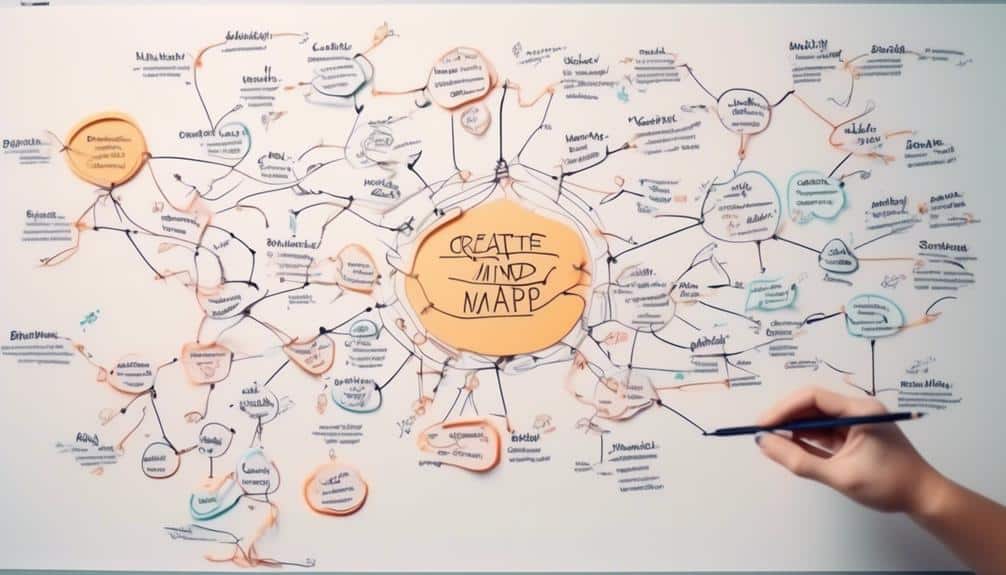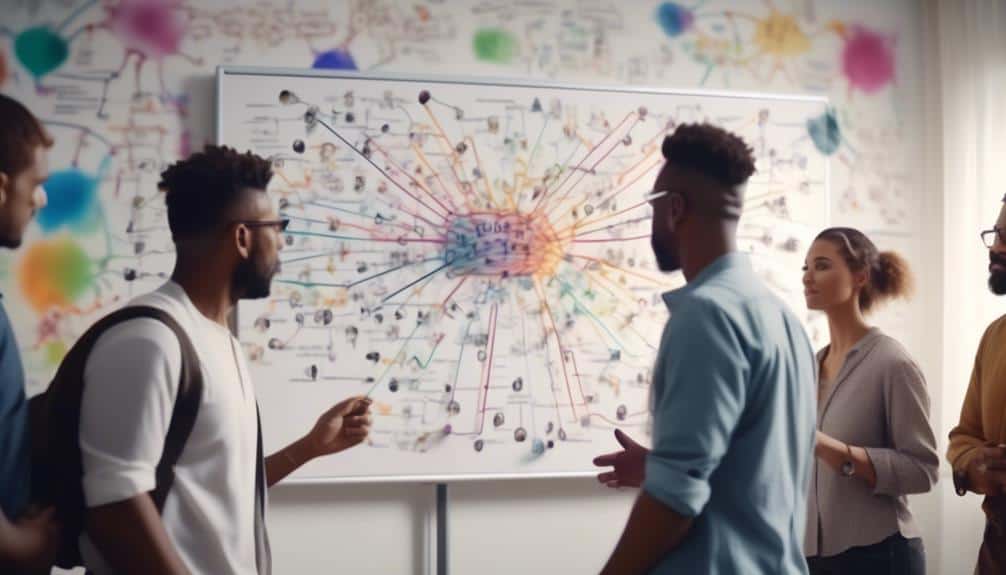Mind Mapping Your Way to Clearer Content Structures
Picture your content creation process as a labyrinth of ideas waiting to be organized – sometimes you find yourself lost amidst the maze of thoughts.
What if there was a tool that could help you navigate this intricate path and lead you to a clearer, more structured destination? Mind mapping offers a solution that can revolutionize the way you approach content creation, providing a visual roadmap that brings order to chaos.
As you embark on this journey of discovery, uncover the key benefits and strategies that will transform your content creation process into a streamlined and efficient endeavor.
Key Takeaways
- Visualize central ideas and related concepts for clarity and organization
- Embrace non-linear thinking to gain new insights and perspectives
- Utilize mind mapping software for efficient digital canvas creation
- Enhance collaboration and creativity through visually appealing and logically structured mind maps
Understanding the Basics of Mind Mapping

To grasp the fundamentals of mind mapping effectively, start by visualizing your central idea and branching out with related concepts. Mind mapping software provides a digital canvas for your ideas, allowing for easy manipulation and organization.
Through visual brainstorming, you can unleash your creativity and connect disparate thoughts in a cohesive manner. Begin by entering your main topic or theme in the center of the canvas and then expand outward with subtopics and key points. Utilize colors, icons, and images to enhance visual appeal and aid in information retention.
When using mind mapping software, remember that simplicity is key. Avoid cluttering your map with excessive details and focus on capturing the essence of each concept succinctly. Use the flexibility of the digital platform to rearrange and refine your ideas as needed.
Embrace the non-linear nature of mind mapping to explore different perspectives and uncover new insights. By mastering the art of visual brainstorming, you can unlock your creative potential and streamline your thought process effectively.
Benefits of Mind Mapping for Content Creation
After grasping the basics of mind mapping and visual brainstorming, you can now uncover the significant benefits it offers for content creation. When it comes to increasing productivity and boosting creativity, mind mapping is a game-changer. Here are five compelling reasons why you should incorporate mind mapping into your content creation process:
- Organizes Your Thoughts: Mind mapping helps you structure your ideas in a visually appealing way, making it easier to see connections and relationships between different concepts.
- Enhances Creativity: By allowing your brain to think freely and make associations, mind mapping can unlock new ideas and innovative solutions.
- Improves Focus: The visual nature of mind maps keeps you on track and prevents distractions, helping you concentrate on the most important aspects of your content.
- Facilitates Collaboration: Mind maps can be shared and edited collaboratively, fostering teamwork and enabling seamless communication among team members.
- Saves Time: By streamlining the content creation process and providing a clear roadmap, mind mapping ultimately saves you time and ensures efficient workflow.
Tools for Digital Mind Mapping

Consider utilizing digital mind mapping tools to enhance your brainstorming and organizational efforts for content creation. These tools offer a dynamic platform for visual brainstorming, allowing you to generate ideas, concepts, and connections in a more engaging and intuitive manner.
Through interactive organization features, you can easily rearrange, link, and categorize information to create a coherent content structure.
Digital mind mapping tools provide a flexible canvas where you can map out your thoughts, outline key points, and visualize the relationships between different elements of your content. With drag-and-drop functionality, customizable templates, and color-coded categories, these tools empower you to design content structures that are both visually appealing and logically structured.
Furthermore, these tools often come with collaboration features, enabling team members to contribute simultaneously to the mind map in real-time. This fosters teamwork, idea sharing, and collective brainstorming sessions, making the content creation process more efficient and collaborative.
Embrace the power of digital mind mapping tools to streamline your content creation workflow and elevate the clarity and impact of your work.
Incorporating Mind Maps Into Your Workflow
Unlock the full potential of your content creation process by seamlessly integrating mind maps into your workflow. Incorporating mind maps can revolutionize the way you approach your tasks, providing a visual and structured way to organize your thoughts and ideas. Here's how you can make the most of this innovative technique:
- Boost Time Management: Mind maps help you break down complex projects into manageable tasks, allowing you to allocate your time effectively.
- Enhance Visual Organization: Visualizing information through mind maps makes it easier to see connections and relationships between different elements, leading to a more organized workflow.
- Improve Idea Generation: Mind maps stimulate creativity by encouraging nonlinear thinking and brainstorming, leading to more innovative solutions.
- Facilitate Collaboration: Sharing mind maps with team members enhances communication and fosters a collaborative environment for idea exchange.
- Streamline Decision-Making: By presenting information in a clear and concise manner, mind maps facilitate quicker and more informed decision-making processes.
Integrating mind maps into your workflow can significantly improve your productivity and creativity, making it a valuable tool for content creators seeking innovative solutions.
Tips for Creating Effective Mind Maps

To create effective mind maps, begin by outlining your main ideas in a clear and structured manner, ensuring each element is interconnected for a comprehensive visual representation. Visual brainstorming is key to unlocking creativity, while content organization ensures that your ideas flow logically within the mind map. Here are some tips to help you craft impactful mind maps:
| Tips for Effective Mind Maps | |||
|---|---|---|---|
| 1. Start with a central idea | 2. Use colors and images | 3. Keep it simple | 4. Connect ideas |
| Begin your mind map with a central theme or keyword to anchor your thoughts. | Incorporate colors, symbols, and images to make your mind map visually appealing and aid in memory retention. | Keep your mind map simple and concise to avoid clutter and confusion. | Establish clear connections between different ideas or branches to maintain a coherent flow of information. |
Enhancing Content Clarity With Mind Mapping
Enhance content clarity effectively through the strategic use of mind mapping techniques. When it comes to improving organization and fostering visual brainstorming, mind mapping is a powerful tool that can elevate your content to new heights. Here are some key strategies to help you enhance content clarity through mind mapping:
- Simplify Complex Ideas: Break down intricate concepts into digestible chunks on your mind map.
- Create Visual Connections: Use colors, icons, and images to establish relationships between different parts of your content.
- Prioritize Information: Arrange your content hierarchically to emphasize the most important points.
- Encourage Creativity: Allow your mind map to evolve organically, sparking new ideas and innovative approaches.
- Enhance Collaboration: Use mind mapping as a collaborative tool to gather input from team members and refine content together.
Mind Mapping for Collaborative Content Projects

For effective collaboration on content projects, utilize mind mapping techniques to streamline ideas and enhance communication among team members. Mind mapping offers a visual and structured approach that aids in organizing thoughts and fostering a shared understanding of project goals. The visual organization of information through mind maps can greatly benefit collaboration dynamics by providing a clear overview of the content structure and highlighting interconnected ideas.
Consider the following table to illustrate how mind mapping can be utilized in collaborative content projects:
| Benefits of Mind Mapping for Collaborative Content Projects | Examples of Impact |
|---|---|
| Enhances communication among team members | Facilitates brainstorming sessions |
| Streamlines ideas and promotes efficient workflows | Clarifies the content hierarchy and key deliverables |
| Fosters a shared understanding of project goals | Aligns team members on the project's direction and objectives |
| Encourages creativity and innovation in content creation | Inspires new ideas and approaches for content development |
| Improves overall project efficiency and productivity | Reduces misunderstandings and enhances team collaboration |
Case Studies: Mind Mapping Success Stories
Discover how real-life Mind Mapping success stories showcase effective planning techniques. These case studies offer valuable insights into how individuals and teams leverage Mind Mapping for structured content creation.
Real-life Mind Mapping
Real-life success stories showcasing the power of mind mapping provide tangible evidence of its effectiveness in enhancing content structures. When individuals implement mind mapping for brainstorming and employ visual organization techniques, remarkable outcomes arise. Consider the following inspiring examples:
- A marketing team streamlined their campaign strategies, resulting in a 30% increase in customer engagement.
- An author structured their novel plot using mind maps, leading to a bestseller publication.
- A student organized complex study material visually, leading to improved exam scores.
- A business executive mapped out project timelines efficiently, ensuring on-time deliveries.
- A designer visualized their creative concepts, fostering innovative design solutions.
These anecdotes underscore how mind mapping can revolutionize your approach to content creation.
Effective Planning Techniques
Having witnessed the tangible benefits of mind mapping in real-life scenarios, it becomes evident that effective planning techniques are pivotal in replicating such success stories. When it comes to time management, mind mapping allows you to visualize tasks, prioritize effectively, and allocate time wisely. Creative brainstorming thrives through mind mapping by encouraging the free flow of ideas and fostering innovative thinking. To illustrate this further, consider the following table showcasing how time management and creative brainstorming intertwine within the realm of effective planning techniques:
| Effective Planning Techniques | Benefits | Tools Used |
|---|---|---|
| Time Management | Enhances productivity | Task lists |
| Creative Brainstorming | Sparks innovation | Mind maps |
Frequently Asked Questions
Can Mind Mapping Be Used for Brainstorming Ideas Outside of Content Creation?
Yes, mind mapping can greatly enhance brainstorming techniques, fostering creativity in problem-solving and innovation. By visually organizing ideas and connections, it allows for a more structured approach to generating and exploring various concepts.
Are There Any Specific Industries or Professions That Benefit the Most From Incorporating Mind Maps Into Their Workflow?
Incorporating mind maps can greatly benefit various industries and professions. The healthcare industry can enhance patient care coordination, while graphic designers can streamline creative workflows. Educators can visualize lesson plans, and legal professionals can organize complex cases efficiently.
How Can Mind Mapping Help With Time Management and Productivity?
To improve time management and productivity, mind mapping offers a structured approach that enhances organization and boosts creativity. By visually mapping out tasks and ideas, you can prioritize effectively and unleash innovative thinking for efficient outcomes.
What Are Some Common Mistakes to Avoid When Creating Mind Maps for Content Structures?
When creating mind maps for content structures, avoid common mistakes like overcrowding with information, neglecting to use visuals for clarity, and rigidly sticking to linear formats. Embrace creative thinking to ensure effective visual organization.
Can Mind Mapping Be Used for Structuring Long-Form Content, Such as Books or Reports?
Yes, mind mapping can revolutionize your approach to structuring long-form content like books or reports. By visually organizing ideas and fostering creative writing, it streamlines strategic planning for projects, enhancing clarity and efficiency.
Conclusion
In conclusion, mind mapping is a powerful tool for creating clearer content structures. By visually organizing your thoughts and ideas, you can streamline your workflow, enhance clarity in your content, and improve collaboration on projects.
Incorporating mind mapping into your process can help you communicate effectively and efficiently, leading to more impactful and engaging content. So why wait? Start mind mapping your way to success today!








